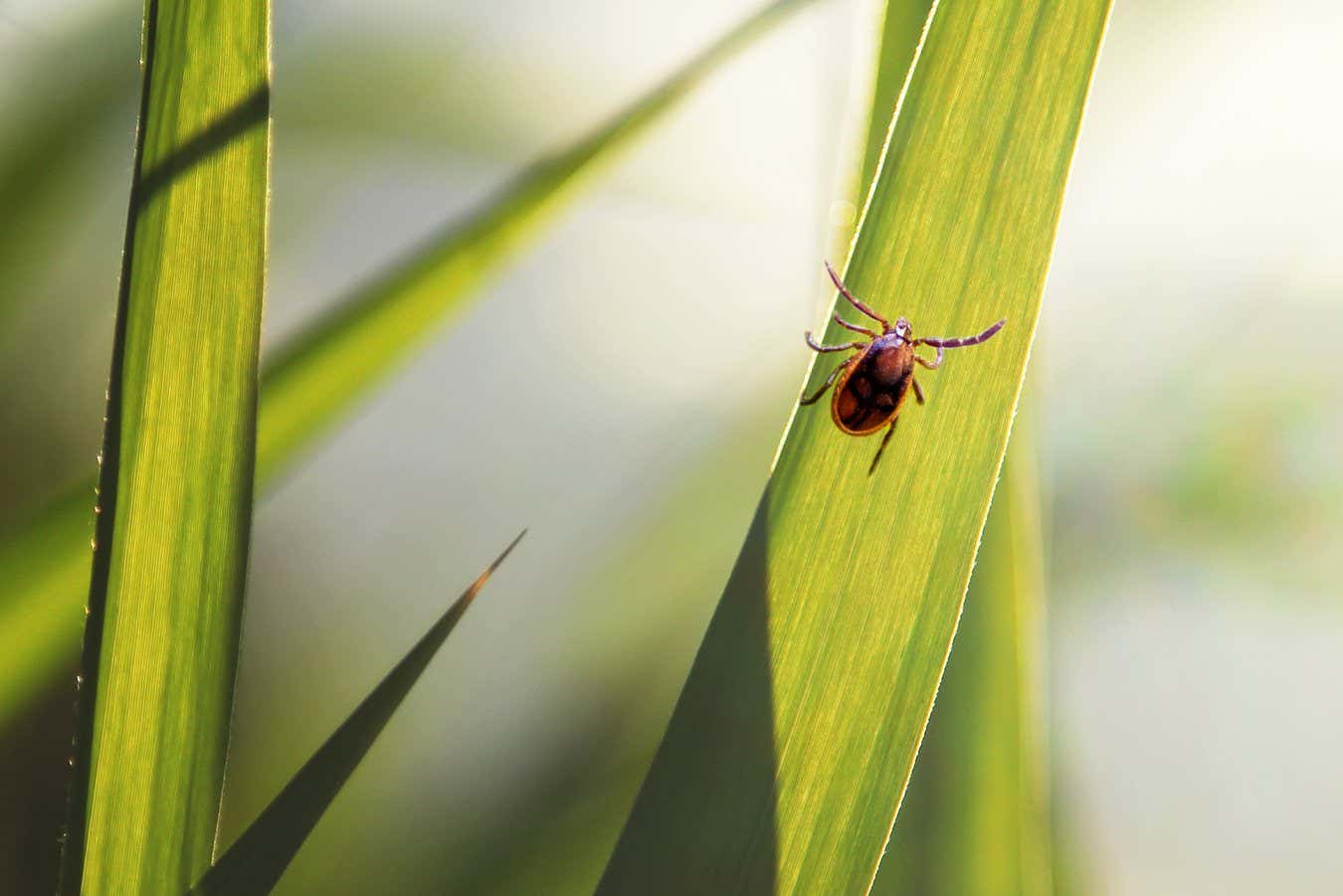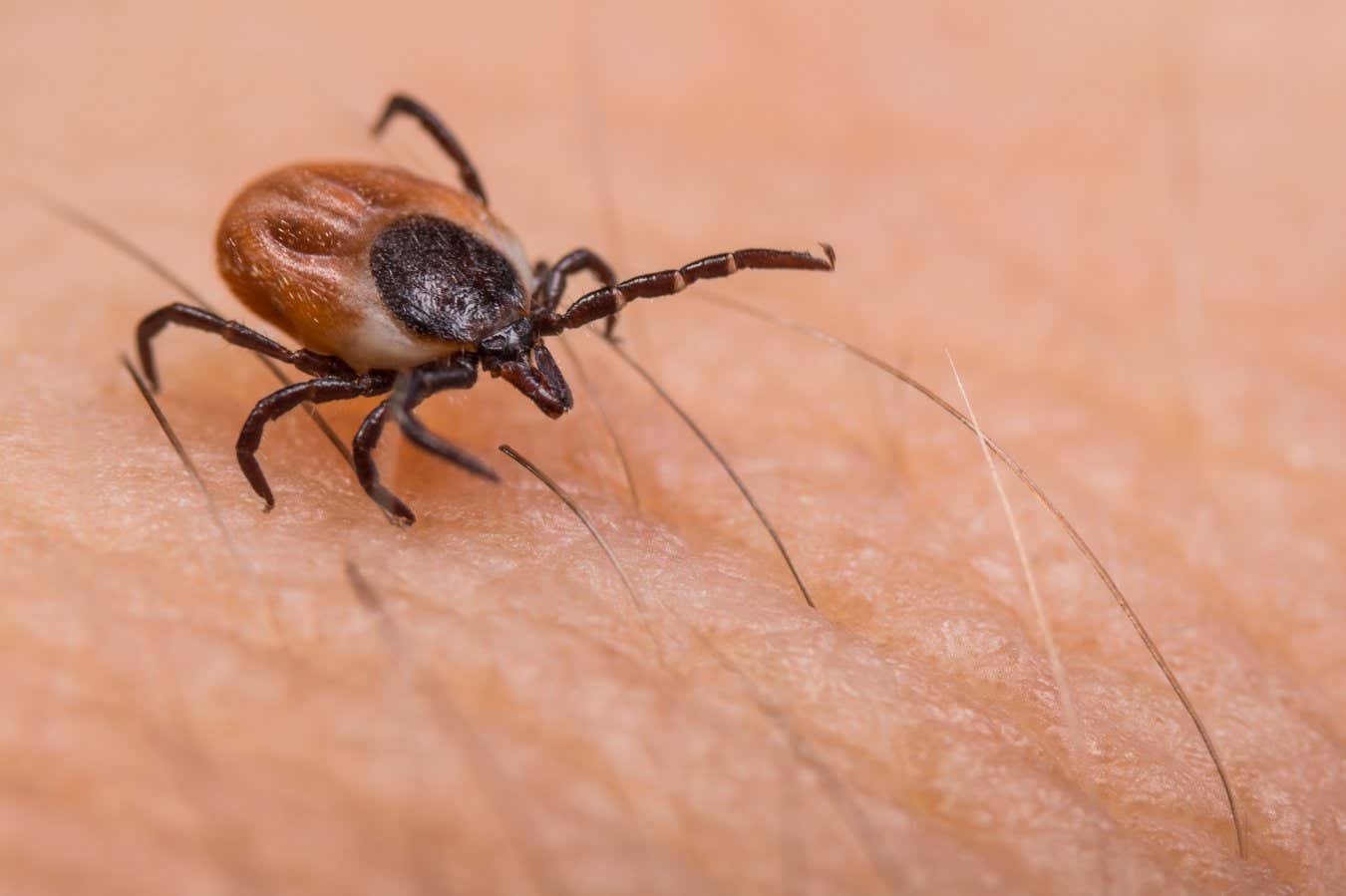
Ticks carry more zoonotic pathogens than any other known vector
Sergey Aleshin/Getty Images
Tucked away in a ground-floor lab in Richmond, Virginia, is a bank of industrial freezers containing thousands of transparent, thumb-sized plastic tubes. Each is filled with a clear, yellowish fluid – blood serum taken from opossums, raccoons, black bears, coyotes, vultures and many other animals.
These vials, the world’s largest collection of blood serum from wildlife, are the life’s work of Virginia Commonwealth University molecular biologist Richard Marconi. Almost every sample here is infected with some kind of tick-borne pathogen – mostly the bacterium that causes Lyme disease, one of the most widespread tick-borne diseases, but others as well.
That means, says Marconi, that most wild animals in North America have been infected. Those animals represent a vast and growing reservoir of viral, parasitic and bacterial pathogens for ticks to pass on to other animals – including humans. In fact, ticks carry more human-infecting pathogens than any other disease-carrying organism.
Right now, tick populations are exploding, their ranges are expanding and they are bringing those pathogens with them. “It’s not just a problem here in the United States. This is occurring across the northern hemisphere,” says Marconi.
We can’t stop ticks from spreading – we’ve tried. That leaves mitigating the damage they do. Marconi’s lab is pioneering a slew of novel protein-editing techniques to generate vaccines against Lyme and other tick-borne illnesses; others are working on vaccines not against these diseases, but against the ticks themselves.
These are promising directions – the only question is: will they be enough?
Just a tick
Around 900 tick species call this planet home. Every one of them feeds on blood.Since branching off from their spider ancestors hundreds of millions of years ago, ticks have evolved a three-pronged mouthpart designed for feeding on vertebrates. Sharp, serrated edges saw through the outer layer of the host’s skin, while a tiny barb anchors the tick to its meal. A thin groove on the underside of the mouthpart’s centre blade funnels blood directly into the tick’s midgut. To prevent their hosts from reacting to their presence, ticks have specialised proteins in their saliva that suppress pain and allergic reactions, while other proteins inhibit blood clotting, allowing ticks to dine at a more leisurely pace. Some tick species feed only on blood from a specific animal host, but others, such as Ixodes scapularis, better known as the deer tick or black-legged tick, are far less choosy.
Ticks have been here a lot longer than we have
The fact that ticks can remain on a host for several days undetected means that where their meals go, they go. And as the planet warms, the number of places ticks can thrive is growing. The highest latitude at which they can live is shifting, says Nick Ogden, an ecologist and epidemiologist at the Public Health Agency of Canada. Ogden and others have documented black-legged ticks as far north as Yukon, above latitude 60° north, brought by migrating songbirds.
“These birds create a conveyor belt for ticks. When the climate becomes suitable, they can set up a population,” says Ogden. Rising temperatures and increased humidity also mean that ticks, though still mainly a spring and summer problem, can be active for more of the year.

Migrating songbirds, like this wood thrush, can be vehicles for ticks
Michael Greenfelder/Alamy
The implications of this tick boom are unfortunately clear: more ticks in more places means more disease. Ticks are superb vehicles for pathogenic hitchhikers, and there are a lot of pathogens looking for rides. For instance, Marconi and his lab looked at blood samples of 128 coyotes from Pennsylvania and found that 64.8 per cent tested positive for the Lyme bacterium and 72.7 per cent for the bacterium that causes anaplasmosis, an infection that leads to flu-like symptoms in humans. Ticks pick up these pathogens when they feed, transferring them to their next host through their saliva or faeces (see “How to avoid ticks – and what to do if you can’t”, below).
“As that tick vector expands its geographical range, all of those diseases are following along,” says Heidi Goethert, a molecular epidemiologist at Tufts University in Massachusetts. In the past 20 years, the annual number of cases of tick-borne diseases in the US has more than doubled. Europe has seen a steady climb in Lyme disease infections, while cases of tick-borne encephalitis, a viral infection that can cause long-term neurological symptoms, have risen by almost 400 per cent in the past 30 years as ticks’ ranges expand north. Human encroachment on wildlife habitats is also increasingly putting people in the way of ticks and their diseases – cases of deadly Rocky Mountain spotted fever have become an “urban epidemic” in Brazilian and Mexican cities, driven by proximity to capybaras and free-roaming dogs.
Ticks are a source of new illnesses as well. In the early 2000s, people in the south-eastern US started turning up in doctors’ offices with classic symptoms of allergic reaction triggered by a previously unheard-of allergen: red meat. In 2009, the lone star tick was confirmed as the source of this allergy to alpha-gal, a sugar found in mammalian meat. Since then, more than 110,000 cases of alpha-gal syndrome have been identified in the US alone. The lone star tick also transmits the sometimes fatal Heartland virus, first documented in 2009, while China has identified 33 emerging tick-borne diseases in the past several decades, including Wetland virus in 2019.
Part of what makes managing the spread of tick-borne disease difficult is that our understanding of tick ecology is incomplete. For example, Martha’s Vineyard, an island off the coast of Massachusetts, has among the highest per capita rates of Lyme disease in the US. White-footed mice were thought to be the ticks’ likeliest pathogen reservoirs. However, efforts to reduce Lyme on the island by targeting mice – coating them with tick-killing pesticides, say – proved inconsistently effective. Trying to figure out why, Goethert and her team spent six years examining what the ticks actually ate, analysing them for tiny fragments of DNA from their last meal. They found that ticks on Martha’s Vineyard preferred shrews to mice – meaning that targeting mice wouldn’t work.
“[Ticks] can transmit lots of different pathogens between lots of different animal types. It’s a very complex ecology,” says Lucy Gilbert, an ecologist at the University of Glasgow in the UK.
A new Lyme disease vaccine
With attempts to manage ticks through their animal hosts proving unsuccessful, researchers like Marconi are instead trying to tackle the diseases they carry.
Lyme disease, transmitted by several species of tick, was first observed in a handful of children in Connecticut in the 1970s. It is now one of the most widespread tick-borne diseases in the world: a 2022 study estimates that 15 percent of the world’s population has been infected with Borreliella (formerly known as Borrelia) burgdorferi, the corkscrew-shaped spirochaete bacteria that causes it.
“These bacteria have this really remarkable structure,” says Marconi, who has developed grudging respect for B. burgdorferi in his 30 years of studying it. “When the tick feeds, spirochaetes literally will drill their way through tissue and spread through the body.”

The deer tick is one of the primary transmitters of the bacterium that causes Lyme disease
Shutterstock/KPixMining
Caught early, Lyme, which often presents with flu-like symptoms and a characteristic bullseye rash, is treatable with antibiotics. However, diagnosing infections can be challenging. Lyme symptoms overlap with those of other illnesses, the rash can be difficult to spot on darker skin and doesn’t always appear, blood tests often give false negatives and – say Marconi and others – doctors don’t always consider Lyme.
“These infections are underappreciated, underdiagnosed and they’re spreading all over the country,” says Isaac Chiu, a neurobiologist who studies Lyme at Harvard Medical School. If left untreated, Lyme can cause a host of neurological symptoms, including facial paralysis, inflammation in the brain and spinal cord, and pain in the joints and muscles. More frustrating, symptoms of infection persist in some people even after a full course of antibiotics.
That’s because B. burgdorferi is tricky. While lurking in a tick’s gut, the bacterium covers itself with a protein called outer surface protein A or OspA. But as soon as the tick gets a taste of mammalian blood, B. burgdorferi switches out OspA for OspC – adapting to its environment, just as we would put on a winter coat on a cold day, says Marconi – and begins its migration to the tick’s salivary glands and on to its new home. Once there, the OspC covering helps it evade the host’s immune system. “It’s a cat-and-mouse game that continues and continues, and it allows the bacterium to remain and persist in the host,” says bacteriologist Troy Bankhead at Washington State University.
That makes B. burgdorferi a difficult vaccine target – although this wasn’t what defeated the first Lyme vaccine. In 1998, GlaxoSmithKline brought a vaccine to market that targeted the OspA protein, but although it was effective, it required boosters as much as every year. That was a hard sell even in areas with high rates of Lyme disease, and it was pulled in 2002.
Marconi believed that targeting the OspC protein would offer broader protection. To do that, however, his team needed to create something completely new. OspC proteins come in 21 different strains, which is why some people contract Lyme disease multiple times. “The Lyme bacteria that might be carried by one tick can differ quite a bit from one that’s carried by another tick,” says Marconi. “We had to come up with a way to make a vaccine candidate that could elicit antibodies against all the strains.”
Using a new technique that he and his lab dubbed “chimeritope technology”, they stitched together small snippets of different OspC protein antigens that provoked an immune response. This super protein proved effective enough for a vaccine for dogs that was approved by the US Food and Drug Administration in 2016. A human vaccine is on its way – Marconi’s lab is currently working with the National Institutes of Health to get it into human trials and then on to market in the next several years.

Ticks tend to be found in tall grass and vegetation
Marcin Rogozinski/Alamy
This isn’t the only Lyme vaccine in the works – with rates of Lyme skyrocketing since 2002, the market has become much more appealing to pharmaceutical companies. Pharmaceutical companies Pfizer and Valneva, working together, are completing the final stage of trials of a second-generation OspA vaccine that generates immunity against the six most common strains of B. burgdorferi in the US and Europe. But Marconi hopes that chimeritope technology will offer a blueprint for managing whatever the next big tick-borne disease will be in North America, as well as a method for combining vaccines to offer protection against multiple tick-borne pathogens at once.
“What’s really exciting to us about it is that we can apply it to any pathogen,” he says, noting that his team is currently working on vaccines for anaplasmosis, cases of which increased 16-fold in the US between 2000 and 2022, and the potentially deadly tick-borne parasite Babesia. “The sky’s the limit on where we can go with it.”
Tackling all tick-borne pathogens
Marconi’s technology might be able to generate vaccines against multiple pathogens and even combine them into a single, multi-use vaccine. But what if we could generate immunity to ticks themselves – and therefore to every pathogen they carry?
It isn’t impossible – some animals naturally develop immunity against ticks after repeated infections. For example, the immune systems of some cattle create antibodies against proteins and other biomolecules carried by the cattle tick. As the tick feeds, these antibodies go straight to the parasite’s midgut, damaging cells and forcing the tick to fall off before it can transmit disease. After scientists identified one of these antibody-generating molecules in the 1980s, anti-tick vaccines for cattle soon appeared on the market. Though imperfect and not universally adopted, the vaccines reliably generated an immune response in cattle and have worked to keep a serious problem from getting worse. Inspired, some scientists are looking to do the same against species of ticks that tend to pose the most problems for humans.
“If this works, it can reduce or prevent multiple tick-borne pathogens – an individual vaccine, you usually can only prevent the one pathogen,” says Yingjun Cui, an infectious diseases researcher at Yale University School of Medicine working on such a vaccine against Lyme-carrying deer ticks.
The anti-tick vaccines currently in the works would incapacitate the main weapon in the tick’s arsenal – its ability to feed off a host undetected. In 2021, Cui and his colleagues showed that immunising guinea pigs with a protein secreted in tick saliva during feeding prompted a histamine response in the animals: the site of the bite swelled, interrupting the ticks’ feeding. Cui’s lab has since identified other candidates for future vaccines. In addition to the swelling, the irritation is a signal to the host to remove the tick before it can transmit disease – a virus can hop from tick to host in about an hour, but bacteria can take up to 48 hours of feeding to make the leap.
“But it’s still not perfect for humans,” says Cui, not least because it is unlikely anyone would want a vaccine that worked in part by giving them an unpleasant reaction to the tick’s bite. Still, his lab isn’t the only one working on an anti-tick vaccine – researchers at the University of Amsterdam are currently working with human volunteers to see if people could generate an immune response after repeated exposure to tick bites.
Marconi is intrigued by the prospect of an anti-tick vaccine, but notes: “We’re willing to tolerate side effects much more in cattle than we probably will be in humans.” For his part, he’s pinning his hope on more traditional vaccines.
“Ticks have been here a lot longer than we have. I think we’re smarter than them, but they’ve learned some tricks that we haven’t been able to quite figure out,” he says. Still, he retains some optimism: “We have our best shot at managing the incidence of disease in humans and in companion animals… It’s a challenge – but I’m not despairing.”
- The best way to avoid a tick-borne disease is to not get bitten at all. Ticks lurk in tall grass or vegetation, waiting for passersby. You can prevent them from latching onto your skin by wearing long trousers, tucked into socks, and long sleeves.
- Check your body, and those of your children and pets. Ticks are often found on the head, the underarms, groin and along the waist and in the belly button, but check everywhere.
- If you do find a tick, use tweezers to grasp it as close to the skin as you can and gently pull up. Try not to twist or crush the tick, as the mouthparts could break off in the skin and cause infection. Dispose of the tick and clean the area with an antiseptic.
- Wash clothing or animal bedding on hot – ticks can survive the washing machine, but not water above 54°C (129°F).
Topics:
Source link : https://www.newscientist.com/article/2482943-tick-borne-diseases-are-booming-but-we-have-new-ways-to-fight-them/?utm_campaign=RSS%7CNSNS&utm_source=NSNS&utm_medium=RSS&utm_content=home
Author :
Publish date : 2025-06-18 16:00:00
Copyright for syndicated content belongs to the linked Source.











